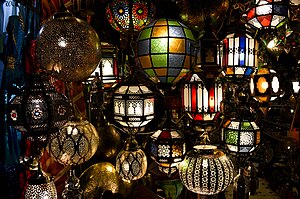
An electric light, lamp, or light bulb is an electrical component that produces light. It is the most common form of artificial lighting. Lamps usually have a base made of ceramic, metal, glass, or plastic, which secures the lamp in the socket of a light fixture, which is often called a "lamp" as well. The electrical connection to the socket may be made with a screw-thread base, two metal pins, two metal caps or a bayonet cap.

An incandescent light bulb, incandescent lamp or incandescent light globe is an electric light with a wire filament heated until it glows. The filament is enclosed in a glass bulb with a vacuum or inert gas to protect the filament from oxidation. Current is supplied to the filament by terminals or wires embedded in the glass. A bulb socket provides mechanical support and electrical connections.
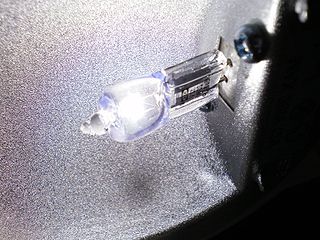
A halogen lamp is an incandescent lamp consisting of a tungsten filament sealed in a compact transparent envelope that is filled with a mixture of an inert gas and a small amount of a halogen, such as iodine or bromine. The combination of the halogen gas and the tungsten filament produces a halogen-cycle chemical reaction, which redeposits evaporated tungsten on the filament, increasing its life and maintaining the clarity of the envelope. This allows the filament to operate at a higher temperature than a standard incandescent lamp of similar power and operating life; this also produces light with higher luminous efficacy and color temperature. The small size of halogen lamps permits their use in compact optical systems for projectors and illumination. The small glass envelope may be enclosed in a much larger outer glass bulb, which has a lower temperature, protects the inner bulb from contamination, and makes the bulb mechanically more similar to a conventional lamp.

Artificial lighting technology began to be developed tens of thousands of years ago and continues to be refined in the present day.

Henry Woodward was a Canadian inventor and a major pioneer in the development of the incandescent lamp. He was born in 1832.

A fluorescent lamp, or fluorescent tube, is a low-pressure mercury-vapor gas-discharge lamp that uses fluorescence to produce visible light. An electric current in the gas excites mercury vapor, which produces short-wave ultraviolet light that then causes a phosphor coating on the inside of the lamp to glow. A fluorescent lamp converts electrical energy into useful light much more efficiently than an incandescent lamp. The typical luminous efficacy of fluorescent lighting systems is 50–100 lumens per watt, several times the efficacy of incandescent bulbs with comparable light output. For comparison, the luminous efficacy of an incandescent bulb may only be 16 lumens per watt.
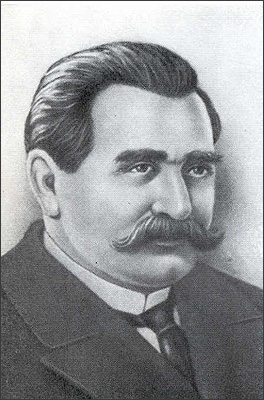
Alexander Nikolayevich Lodygin, known after immigration to US as Alexandre de Lodyguine was a Russian electrical engineer and inventor, one of the inventors of the incandescent light bulb.

A mercury-vapor lamp is a gas-discharge lamp that uses an electric arc through vaporized mercury to produce light. The arc discharge is generally confined to a small fused quartz arc tube mounted within a larger soda lime or borosilicate glass bulb. The outer bulb may be clear or coated with a phosphor; in either case, the outer bulb provides thermal insulation, protection from the ultraviolet radiation the light produces, and a convenient mounting for the fused quartz arc tube.

The history of street lighting in the United States is closely linked to the urbanization of America. Artificial illumination has stimulated commercial activity at night, and has been tied to the country's economic development, including major innovations in transportation, particularly the growth in automobile use. In the two and a half centuries before LED lighting emerged as the new "gold standard", cities and towns across America relied on oil, coal gas, carbon arc, incandescent, and high-intensity gas discharge lamps for street lighting.

A metal-halide lamp is an electrical lamp that produces light by an electric arc through a gaseous mixture of vaporized mercury and metal halides. It is a type of high-intensity discharge (HID) gas discharge lamp. Developed in the 1960s, they are similar to mercury vapor lamps, but contain additional metal halide compounds in the quartz arc tube, which improve the efficiency and color rendition of the light. The most common metal halide compound used is sodium iodide. Once the arc tube reaches its running temperature, the sodium dissociates from the iodine, adding orange and reds to the lamp's spectrum from the sodium D line as the metal ionizes. As a result, metal-halide lamps have high luminous efficacy of around 75–100 lumens per watt, which is about twice that of mercury vapor lights and 3 to 5 times that of incandescent lights and produce an intense white light. Lamp life is 6,000 to 15,000 hours. As one of the most efficient sources of high CRI white light, metal halides as of 2005 were the fastest growing segment of the lighting industry. They are used for wide area overhead lighting of commercial, industrial, and public places, such as parking lots, sports arenas, factories, and retail stores, as well as residential security lighting, automotive headlamps and indoor cannabis grow operations.

Tungsram was a manufacturing company located in Hungary and known for their light bulbs and electronics. Established in Újpest in 1896, it initially produced telephones, wires and switchboards. The name "Tungsram" is a portmanteau of tungsten and wolfram, the two common names of the metal used for making light bulb filaments. Before becoming nationalized by the Communist government in 1945, the company was the world's third largest manufacturer of light bulbs and radiotubes, after the American General Electric and RCA companies.
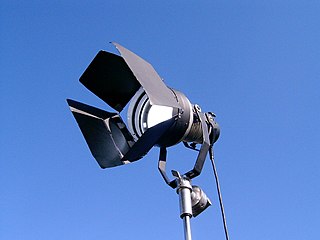
Hydrargyrum medium-arc iodide (HMI) is the trademark name of Osram's brand of metal-halide gas discharge medium arc-length lamp, made specifically for film and entertainment applications. Hydrargyrum comes from the Greek name for the element mercury.

A lampshade is a fixture that envelops the lightbulb on a lamp to diffuse the light it emits. Lampshades can be made out of a large variety of materials like paper, glass, fabric or stone. Often times conical or cylindrical in shape, lampshades can be found on floor, desk, tabletop, or suspended lamps. The term can also apply to the glass hung around many designs of ceiling lamp. Beyond its practical purpose, significant emphasis is also usually given to decorative and aesthetic features. A lamp shade also serves to "shade" human eyes from the direct glare of the light bulbs used to illuminate the lamp. Some lamp shades are also lined with a hard-backed opaque lining, often white or gold, to reflect as much light as possible through the top and bottom of the shade while blocking light from emitting through the walls of the shade itself. In other cases, the shade material is deliberately decorative so that upon illumination it may emphasize a display of color and light emitting through the shade surface itself.

Mazda was a trademarked name registered by General Electric (GE) in 1909 for incandescent light bulbs. The name was used from 1909 to 1945 in the United States by GE and Westinghouse. Mazda brand light bulbs were made for decades after 1945 outside the US. The company chose the name due to its association with Ahura Mazda, the transcendental and universal God of Zoroastrianism whose name means light of wisdom in the Avestan language.

Stage lighting instruments are used in stage lighting to illuminate theatrical productions, concerts, and other performances taking place in live performance venues. They are also used to light television studios and sound stages.
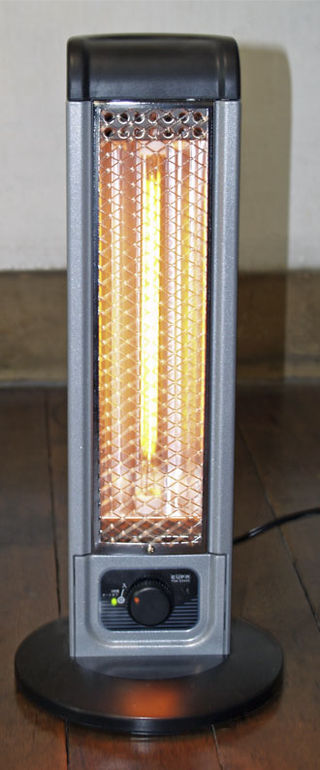
An infrared heater or heat lamp is a heating appliance containing a high-temperature emitter that transfers energy to a cooler object through electromagnetic radiation. Depending on the temperature of the emitter, the wavelength of the peak of the infrared radiation ranges from 750 nm to 1 mm. No contact or medium between the emitter and cool object is needed for the energy transfer. Infrared heaters can be operated in vacuum or atmosphere.

An LED lamp or LED light bulb is an electric light that produces light using light-emitting diodes (LEDs). LED lamps are significantly more energy-efficient than equivalent incandescent lamps and can be significantly more than most fluorescent lamps. The most efficient commercially available LED lamps have efficiencies of 200 lumen per watt (Lm/W). Commercial LED lamps have a lifespan many times longer than incandescent lamps.
United States Lighting Energy Policy is moving towards increased efficiency in order to lower greenhouse gas emissions and energy use. Lighting efficiency improvements in the United States can be seen through different standards and acts. The Energy Independence and Security Act of 2007 laid out changes in lighting legislation for the United States. This set up performance standards and the phase-out of incandescent light bulbs in order to require the use of more efficient fluorescent lighting. EISA 2007 is an effort to increase lighting efficiency by 25-30%. Opposition to EISA 2007 is demonstrated by the Better Use of Light Bulbs Act and the Light Bulb Freedom of Choice Act. The efforts to increase lighting efficiency are also demonstrated by the Energy Star program and the increase efficiency goals by 2011 and 2013.

Alexander Friedrich Just was an Austro-Hungarian chemist and inventor. Later, in Hungary he used the name Just Sándor Frigyes. In 1904 with Austro-Hungarian Franjo Hanaman he was the first to develop and patent an incandescent light bulb with a tungsten filament, made by extruding a paste of tungsten powder and a carbonaceous binder to produce a fine thread, then removing the carbon by heating in an atmosphere of hydrogen and water vapors. Just and Hanaman received a Hungarian patent in 1904, and later US Patent 1,018,502. In 1905, Just and Hanaman patented a process for producing tungsten filaments by plating carbon filaments with tungsten, then removing the carbon by heating. These early tungsten lamps were more efficient than a carbon filament lamp, because they could operate at a high temperature, due to the high melting point of tungsten. The tungsten was, however, so brittle that these lamps were of limited practical use. It was supplanted by the drawn tungsten filament lamp, developed in 1910 by William David Coolidge.

A LED filament light bulb is a LED lamp which is designed to resemble a traditional incandescent light bulb with visible filaments for aesthetic and light distribution purposes, but with the high efficiency of light-emitting diodes (LEDs). It produces its light using LED filaments, which are series-connected strings of diodes that resemble in appearance the filaments of incandescent light bulbs. They are direct replacements for conventional clear incandescent bulbs, as they are made with the same envelope shapes, the same bases that fit the same sockets, and work at the same supply voltage. They may be used for their appearance, similar when lit to a clear incandescent bulb, or for their wide angle of light distribution, typically 300°. They are also more efficient than many other LED lamps.























